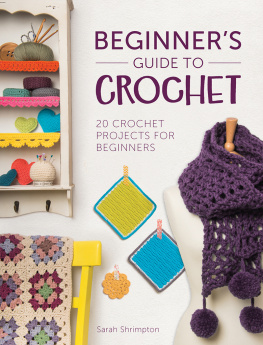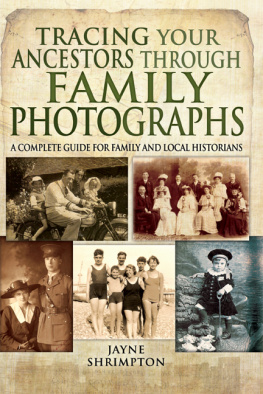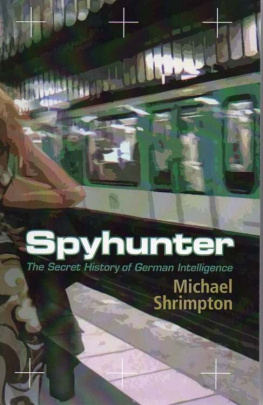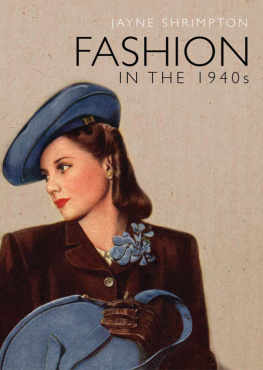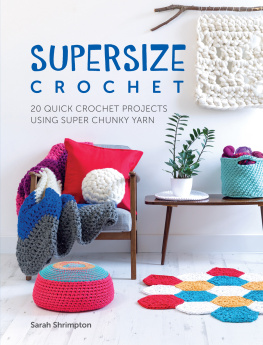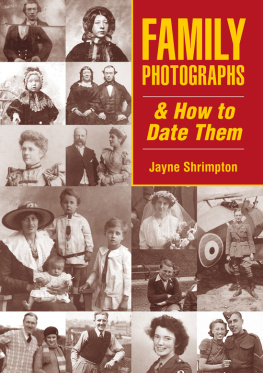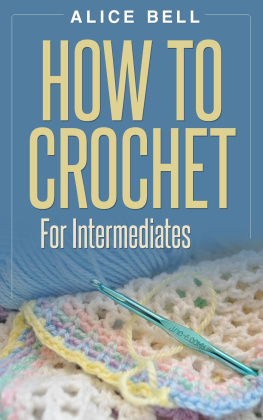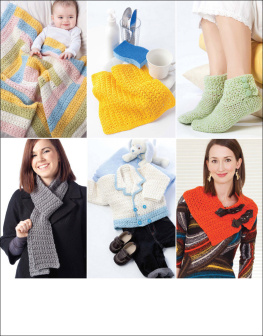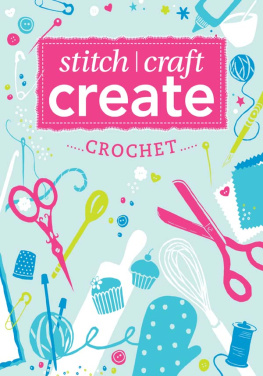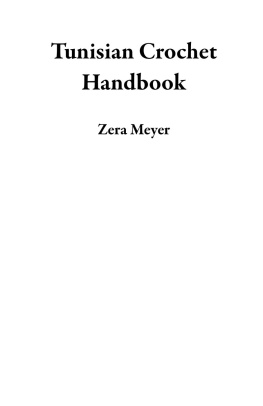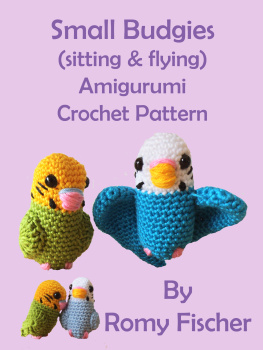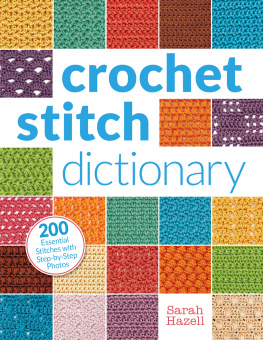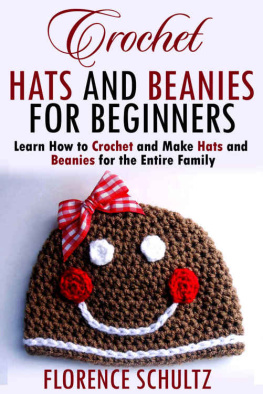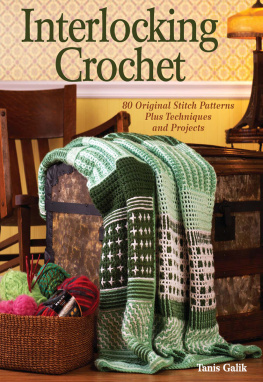Contents
Guide
BEGINNERS
GUIDE TO
CROCHET
20 CROCHET
PROJECTS FOR
BEGINNERS
Sarah Shrimpton

www.stitchcraftcreate.co.uk
CONTENTS
INTRODUCTION
So youve decided to learn to crochet? Excellent news! Youll love it, you really will. Crochet is good for the soul, the heart and the hands, and learning a new skill is great for the grey matter, too.
Once you can crochet, you will never again wonder what to do on a wet Saturday afternoon, or be bored on a lengthy car journey (as a passenger, I hasten to add!). Soon, crochet will become your constant companion as your spare moments are spent planning new projects and your home becomes filled with the wonderful things you have made. As for birthday and Christmas presents, youll be hooking up beautiful handmade gifts in no time.
In fact, crochet can be used to make just about anything your creative heart desires. Want to make a cushion cover? What about a rug? How about a teddy bear, scarf, slippers, belt, poncho? You know the answer, dear reader, crochet it.
What makes crochet so versatile is that it can be made in three different ways:
First, by hooking back and forth in rows to create flat pieces; these can be shaped and stitched together to construct something like a jumper or shawl.
Secondly, by working in rounds to produce circles; this is useful for rugs and coasters, but also important for starting many motifs, like granny squares, which can be joined together to make larger items, like blankets.
Thirdly, in three-dimensions; you work in rounds again but additional shaping can create spheres, sausage shapes, cones and cylinders, which can be used for toys, hats, bags and bowls.
All this with just a little hook and a length of yarn.
Theres no messing around with circular hooks or cable hooks or double-pointed hooks here (yes, knitting, Im talking about you). No, a standard hook is all you need to work in these three different ways. The reason for not needing lots of fancy-pants hooks is quite simple; in crochet, you only work with one stitch at a time and that is the one on your hook. Theres no wrestling with hundreds of stitches on a stick and no cursing when you realize youve dropped one somewhere and the rest have slid off the stick and are now around your ankles (sorry, knitting, but Im talking about you again). Crochet is altogether more forgiving, so even if you make a mistake (and we all do), it doesnt go and unravel itself all over the floor and you wont end up with gaping holes in the middle of your work.
To top all of this, did you know there are actually only a handful of stitches you need to learn to be competent at this super-yarny craft? Its what you do with them that can create something as simple as a dishcloth or as complicated as a doily.
So pull up a comfy chair, get yourself settled and Ill tell you everything you need to know.
Sarah x
P.S. I am not anti-knitting. I love knitting, and all knitty things. I really do.
P.P.S. You can actually get double-ended hooks, but thats an entirely different ball game and you wont need one for this book.
HOW TO USE THIS BOOK
Many crochet books follow a similar format; they have a section at the front explaining how to make all of the stitches, followed by the patterns, many of which combine several different stitches and techniques, not all of them suitable for a novice.
This book, however, is quite different. It has been carefully designed to teach you little by little. Who expects a crochet newbie to try learning all the stitches first and then attempt a complicated pattern? Not I. That would be madness!
No, well start at the very beginning and Ill show you what you need to have in your crochet kit. Well have a little chat about patterns and charts before moving on to the exciting stuff, where youll find out how to hold your hook and yarn and then youll be ready to learn your first stitch. Youll need to have a little practise and once youre ready (it wont be long), you can tackle the accompanying project, which uses exactly what you have just learnt.
It makes sense, doesnt it? And youll have made your very first piece of crochet on your very first day of learning! Hoorah!
The book continues in this way throughout; learn a new stitch or technique, practise, and then hone your new skills by making something with what you know. There are 20 wonderful projects to work through, which teach the basics of crocheting, along with other useful tips. The projects combine simple, modern design with a fairly quick outcome some can be completed in less than an hour and most you should be able to finish in just a few hours. Each project details the yarn and hook I used to make the item, but of course you can choose your own and Ill tell you how to do that, too.
Youll be hooked in no time.
YOUR CROCHET TOOLKIT

Every craft needs a toolkit and crochet is no different. Apart from hooks and yarn, which will be covered on the next pages, some of the most useful things youll need are:
SCISSORS
It goes without saying that youll need to cut things when crocheting, yarn, threads, felt or material, and youll need a decent pair of scissors for the task. Keep the kids away from them and theyll stay sharp (unlike mine, which are encrusted with glue and blunt as a spoon).
TAPESTRY/DARNING NEEDLE
When you have completed your beautiful piece of crochet, youll have yarn ends to get rid of. You can do this by simply sewing them into your work to hide them. Tapestry needles have a blunt end, so they dont catch on your stitches, and a large eye to thread the yarn through.
STITCH MARKER
When crocheting, youll often want to identify an important stitch in your work. It might be the first stitch of a round, or a particularly tricky stitch to see. There are many designs available, but you can always use a piece of different coloured yarn and hook this through your stitch instead.
ROW COUNTER
This is useful for keeping track of how many rows or rounds you have completed. You can buy a traditional barrel-shaped counter, download an app or keep a tally with pen and paper.
SEWING NEEDLE
This is a sharp-ended needle and therefore perfect for attaching pretty things like ribbons and buttons to your work. It has a smaller eye as it will be used with cotton or embroidery threads.
THREAD
If you want to attach pretty things to your crochet, then youll need some cotton thread. White and black are a staple in my kit, but you may want a few more colours for variety.
You may also like to embroider onto your crochet and if so, youll want some embroidery threads in your stash, too.
TOY STUFFING
When making a plush item youll need to fill it with something fluffy. Commercially produced toy stuffing is readily available and will add substance to your toys and cushions whilst conforming to all the proper safety guidelines.
SAFETY EYES
Not to be confused with safety goggles, safety eyes are the little plastic eyes used in toy making. You can, of course, embroider features onto your wonderful creation, but you may prefer to use safety eyes instead. Safety eyes are so called because they are pushed into your crochet and secured at the back with a tight-fitting washer, making them nigh on impossible to remove.

